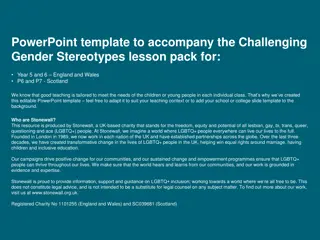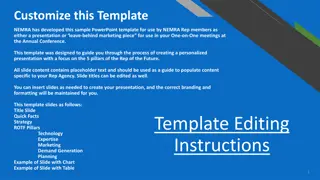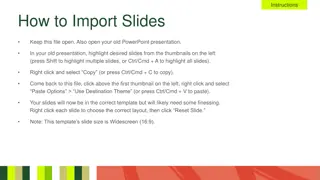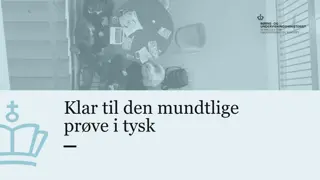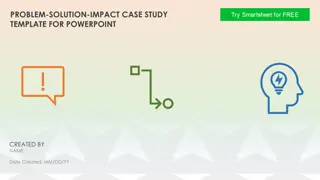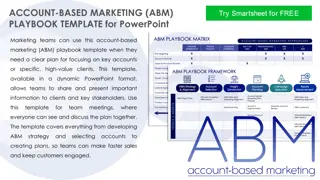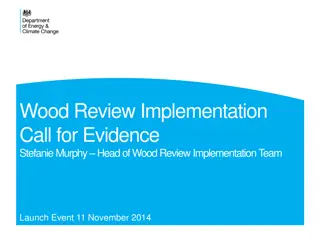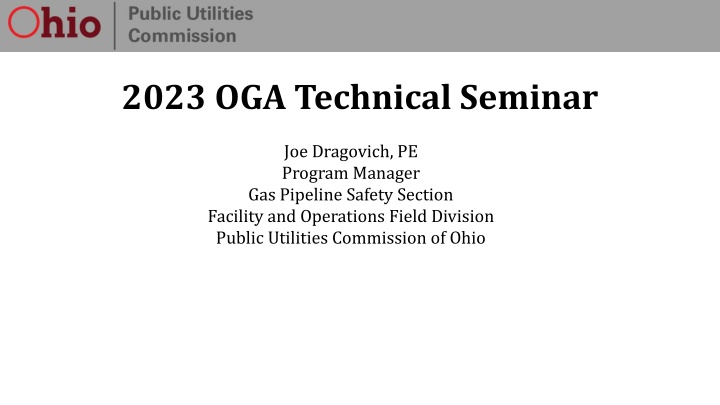
Gas Pipeline Safety Section Annual Reports and Inspections Overview
Explore key topics discussed at the 2023 OGA Technical Seminar, including annual reports, inspections, and the PIPES Act of 2020. Learn about requirements for gas pipeline operators in Ohio, filing deadlines, inspection standards, and compliance updates. Stay informed about regulations, reporting procedures, and assessment assessments in the gas pipeline industry.
Download Presentation

Please find below an Image/Link to download the presentation.
The content on the website is provided AS IS for your information and personal use only. It may not be sold, licensed, or shared on other websites without obtaining consent from the author. If you encounter any issues during the download, it is possible that the publisher has removed the file from their server.
You are allowed to download the files provided on this website for personal or commercial use, subject to the condition that they are used lawfully. All files are the property of their respective owners.
The content on the website is provided AS IS for your information and personal use only. It may not be sold, licensed, or shared on other websites without obtaining consent from the author.
E N D
Presentation Transcript
2023 OGA Technical Seminar Joe Dragovich, PE Program Manager Gas Pipeline Safety Section Facility and Operations Field Division Public Utilities Commission of Ohio
Gas Pipeline Safety Section Program Manager - Joe Dragovich, PE Support Staff - Tom Stikeleather Field Staff Dennis Cramer Chris Domonkos Josh Knox Scott Landon, PE Mary McKelvey Victor Omameh Jeff Polka Dave Price Mike Purcell Keith Topovski
Topics Annual Reports and Throughput 2023 Inspections Incident Reporting and Investigations State Rule Changes Federal Rule Updates Advisory Bulletins
Annual Reports and Throughput CaseNo.23-002-PL-RPTdirects all gas pipeline operators to file a 2022 Gas Pipeline Safety annual report by March 30, 2023. Pursuant to R.C. 4905.92, all pipeline operators, including natural gas companies, pipeline companies, master-meter system operators, municipal corporations, and cooperative associations, when engaged in supplying or transporting gas by pipeline in the state of Ohio, are required annually to report the prior year s total throughput of gas, in thousands of cubic feet (Mcfs), supplied or delivered in the state and to pay the gas pipeline safety (GPS) assessment. To file, please use the PUCO's web-based filing system, the PUCO Community to submit the throughput report as well as add the additional required forms.
2023 Inspections Separated Standard Records Inspections into two forms last year One form covers questions that apply company-wide This will be filled out once for every operator Includes damage prevention questions Second form used for shop specific records questions and field observations This will include our normal records and field related questions and space for field observations This will be filled out for each shop/operating area For smaller operators this will only be filled out once For larger operators with multiple inspection units this will be filled out for each unit
PIPES Act of 2020 - Section 114 Inspection All operators completed in 2022 PHMSA did not collect our reports but did ask us to report completion dates for each operator and whether we had any enforcement or compliance issues These will be required again in 5 years
Future Plans Split transmission form and gathering form into separate forms May develop stand alone MAOP reconfirmation form
Incident Reporting and Investigations
IncidentReporting Incident Criteria 191.3 definition 191.5 reporting requirements Who to call NRC (1-800-424-8802) OHCall1 - (1-844-642-2551) Program Manager (614-361-0464) If you can t reach me call Pete Chace (614-561-6880) Other reasons to call us Outage of 100+ customers for 2+ hours Media Coverage
IncidentCriteria An event that involves the release of gas that results in: A death, or personal injury necessitating in-patient hospitalization; Estimated property damage of $50,000/$129,300 or more, including a loss to the operator and others, or both, but excluding the cost of gas lost; or Unintentional estimated gas loss of three million cubic feet or more.
FederalReporting Language 191.5 Immediate notice of certain incidents. a) At the earliest practicable moment following discovery, but no later than one hour after confirmed discovery, each operator must give notice in accordance with paragraph (b) of this section of each incident as defined in 191.3. b) Each notice required by paragraph (a) of this section must be made to the National Response Center either by telephone to 800-424-8802 (in Washington, DC, 202 267-2675) or electronically at http://www.nrc.uscg.mil and must include the following information: 1. Names of operator and person making report and their telephone numbers. 2. The location of the incident. 3. The time of the incident. 4. The number of fatalities and personal injuries, if any. 5. All other significant facts that are known by the operator that are relevant to the cause of the incident or extent of the damages. c) Within 48 hours after the confirmed discovery of an incident, to the extent practicable, an operator must revise or confirm its initial telephonic notice required in paragraph (b) of this section with an estimate of the amount of product released, an estimate of the number of fatalities and injuries, and all other significant facts that are known by the operator that are relevant to the cause of the incident or extent of the damages. If there are no changes or revisions to the initial report, the operator must confirm the estimates in its initial report.
StateReporting Language 4901:1-16-05: Notice and reports of service failures and incidents; twenty-four hour contacts; one-call participation; post-incident testing; and cast iron pipeline program. A. Telephone notice of incidents and service failures. 1. Operators shall notify the state of Ohio on all incidents, as defined in rule 4901:1-16-01 of the Administrative Code, by calling 1-844-OHCALL1 (1-844-642-2551) within thirty minutes of discovery unless notification within that time is impracticable under the circumstances. This includes any telephone notice which is required to be made to the United States department of transportation pursuant to 49 C.F.R. 40, 191, 192, and 199 as effective on the date referenced in paragraph (D) of rule 4901:1-16-02 of the Administrative Code. 2. Operators shall notify the state of Ohio on all service failures, which involve an interruption of service to one hundred or more customers for a period of two hours or more, by calling 1-844-OHCALL1 (1-844-642-2551) within thirty minutes after discovery unless notification within that time is impracticable under the circumstances.
Previous Language in 192.617 Each operator shall establish procedures for analyzing accidents and failures, including the selection of samples of the failed facility or equipment for laboratory examination, where appropriate, for the purpose of determining the causes of the failure and minimizing the possibility of a recurrence.
New Language in 192.617 (a) Post-failure and incident procedures. Each operator must establish and follow procedures for investigating and analyzing failures and incidents as defined in 191.3, including sending the failed pipe, component, or equipment for laboratory testing or examination, where appropriate, for the purpose of determining the causes and contributing factor(s) of the failure or incident and minimizing the possibility of a recurrence. (b) Post-failure and incident lessons learned. Each operator must develop, implement, and incorporate lessons learned from a post-failure or incident review into its written procedures, including personnel training and qualification programs, and design, construction, testing, maintenance, operations, and emergency procedure manuals and specifications.
New Language in 192.617 cont. (c) Analysis of rupture and valve shut-offs. If an incident on an onshore gas transmission pipeline or a Type A gathering pipeline involves the closure of a rupture-mitigation valve (RMV), as defined in 192.3, or the closure of alternative equivalent technology, the operator of the pipeline must also conduct a post-incident analysis of all of the factors that may have impacted the release volume and the consequences of the incident and identify and implement operations and maintenance measures to prevent or minimize the consequences of a future incident. The requirements of this paragraph (c) are not applicable to distribution pipelines or Types B and C gas gathering pipelines. The analysis must include all relevant factors impacting the release volume and consequences, including, but not limited to, the following: (1) Detection, identification, operational response, system shut- off, and emergency response communications, based on the type and volume of the incident; (2) Appropriateness and effectiveness of procedures and pipeline systems, including supervisory control and data acquisition (SCADA), communications, valve shut-off, and operator personnel; (3) Actual response time from identifying a rupture following a notification of potential rupture, as defined at 192.3, to initiation of mitigative actions and isolation of the pipeline segment, and the appropriateness and effectiveness of the mitigative actions taken; (4) Location and timeliness of actuation of RMVs or alternative equivalent technologies; and (5) All other factors the operator deems appropriate.
New Language in 192.617 cont. (d) Rupture post-failure and incident summary. If a failure or incident on an onshore gas transmission pipeline or a Type A gathering pipeline involves the identification of a rupture following a notification of potential rupture, or the closure of an RMV (as those terms are defined in 192.3), or the closure of an alternative equivalent technology, the operator of the pipeline must complete a summary of the post-failure or incident review required by paragraph (c) of this section within 90 days of the incident, and while the investigation is pending, conduct quarterly status reviews until the investigation is complete and a final post- incident summary is prepared. The final post-failure or incident summary, and all other reviews and analyses produced under the requirements of this section, must be reviewed, dated, and signed by the operator's appropriate senior executive officer. The final post-failure or incident summary, all investigation and analysis documents used to prepare it, and records of lessons learned must be kept for the useful life of the pipeline. The requirements of this paragraph (d) are not applicable to distribution pipelines or Types B and C gas gathering pipelines.
Incident Response Related Records Records from the initial response : Confirm the address or location. What incident criteria was met that made this reportable? Timeline of events including (but not limited to): o Time operator was notified o Time first responder arrived o Time gas was turned off o Time of leak survey of immediate area o Time of odor level check o Time of any other testing that was completed Records of emergency response activities: o Leak survey o Odor level check o Any pressure testing activity performed o OUPS tickets for any excavation required for testing or emergency response activities
Other Records to Begin Gathering Facilities related records we will request: Service line drawing/tap card which should include Materials Installation date Pressure test record Meter make and model Service call history for address MAOP of system System operating pressure at time of event If applicable Data from meter showing usage history leading up to event Service regulator make and model
2021 State Rule Changes Inactive Service Lines language on next slide Construction Reporting down to 2 reports instead of 3 Eliminated requirements for annual construction report and annual incident and outage report. Electronic Communications we may send some things via email instead of mailing a hard copy Updated code reference
Inactive Service Lines (J) Beginning 24 months after the effective date of this rule, each operator will have a plan for tracking and abandoning inactive service lines in accordance with 49 CFR 192.727 and will have a copy of its plan available for inspection. The plan will include the following: (1) A service line is considered inactive and ready for abandonment when gas has not been billed to any customers served by the line for a period of 36 months. (2) Beginning 48 months after the effective date of this rule, inactive service lines will be abandoned within 12 months of becoming inactive as defined in paragraph (J)(1) of this rule unless the operator determines there is a reasonable prospect for future use. (3) Until a service line is abandoned under paragraph (J)(2) of this rule, the service line will be treated as active for the purpose of applying the requirements of the pipeline safety code. (4) Unrecorded inactive service lines discovered in the course of leakage surveillance, construction, maintenance or inspection of facilities will be abandoned as soon as practicable but no later than 12 months after discovery. Unrecorded service lines that are not abandoned immediately upon discovery will also be fully located and leak surveyed within 10 days of discovery and incorporated into maps of the operator s service area until they are properly abandoned.
Effective Date The effective date of this rule was August 5, 2021 which means the requirements of (J) go into effect August 5, 2023. (J) Beginning 24 months after the effective date of this rule, each operator will have a plan for tracking and abandoning inactive service lines in accordance with 49 CFR 192.727 and will have a copy of its plan available for inspection. The plan will include the following: In a future rule update we will revise this to say As of August 5, 2023
Regulatory Reduction In 2022, Senate Bill 9 required all agencies to reduce regulatory requirements by 30% by June 30, 2025 The PUCO is working through that process
Federal Rule Updates RIN 1 RIN 2 RIN 3 Valve Rule Leak Detection Safety of Gas Distribution Lines Idled Pipelines Class Location Change Requirements LNG Rule CO2 Rule Standards Updates
Safety of Gas Transmission Lines (RIN-1) Published in Federal Register on October 1, 2019; effective date of July 1, 2020 Addresses MAOP Reconfirmation, use of Engineering Critical Assessment as an option, created Moderate Consequence Areas, grandfathered pipelines clause eliminated, mitigation methods, etc. Some changes immediate, others have compliance dates several years in the future PHMSA has published a set of Frequently Asked Questions (FAQs), Batch 1 and Batch 2 PHMSA is conducting inspections with interstate operators to evaluate how they are and will comply with the new Gas Transmission Rules Operators should be revising procedures to ensure compliance with the current and future rules Workshops and/or training will be scheduled by PHMSA
Safety of Gas Transmission Lines (RIN-2) NPRM published 4/8/2016 Comment period closed 7/7/2016 Split from original Gas Transmission NPRM GPAC meetings held January 2017; June 2017, Dec 2017, March 2018Fina Final rule published 8/24/2022; effective date May 24, 2023 Stay of enforcement issued for some parts until February 24, 2024
Safety of Gas Transmission Lines (RIN-2) Accordingly, to ensure timely, careful, and complete implementation of the safety- and environment- improving requirements of the Final Rule, PHMSA will exercise its inherent enforcement discretion to refrain from taking enforcement action alleging violations of the Final Rule s requirements (subject to certain exceptions described below) for nine additional months(i.e., from May 24, 2023, to February 24, 2024) against operators of existing onshore gas transmission pipelines in-service as of the publication date of the Final Rule on August 24, 2022. During that nine-month period, PHMSA will prepare and issue guidance to aid operators in their compliance with the Final Rule. This enforcement discretion will not apply to (1) those provisions of the Final Rule for which the Final Rule prescribed independent compliance timelines (i.e., 49 CFR 192.917(b) and 192.13(d)); and (2) pipelines that are new or replaced after August 24, 2022. PHMSA will memorialize this enforcement discretion within implementation material for PHMSA inspectors and recommend that its state partners conform to the contents of this limited enforcement discretion. This enforcement discretion will remain in effect until February 24, 2024.
Safety of Gas Transmission Lines (RIN-2) Major Topics Include Repair criteria for both HCA and non-HCA areas Extreme weather inspections Strengthening assessment requirements Corrosion control Management of change IM clarifications Definitional changes, including the definition of Transmission line and Distribution center
Safety of Gas Transmission Lines (RIN-2) Distribution center means the initial point where gas enters piping used primarily to deliver gas to customers who purchase it for consumption, as opposed to customers who purchase it for resale, for example: (1) At a metering location; (2) A pressure reduction location; or (3) Where there is a reduction in the volume of gas, such as a lateral off a transmission line.
Safety of Gas Transmission Lines (RIN-2) Transmission line means a pipeline or connected series of pipelines, other than a gathering line, that: (1) Transports gas from a gathering pipeline or storage facility to a distribution center, storage facility, or large volume customer that is not down-stream from a distribution center; (2) Has an MAOP of 20 percent or more of SMYS; (3) Transports gas within a storage field; or (4) Is voluntarily designated by the operator as a transmission pipeline.
RIN 3: Gathering Line Regulations Published in Federal Register on November 15, 2021 Effective Date is May 16, 2022 Major Topics include Reporting Definition Changes Regulation of large diameter HP lines
Compliance Dates Publication Date: 11/15/2021 Effective Date: May 16, 2022 Reporting Incident Reports: Report events occurring after May 16, 2022 Annual Reports: 2022 reports due March 2023 Identify Type C lines: November 16, 2022 Section 192.9 compliance: May 16, 2023 MAOP lookback: 5-year period ending May 16, 2023
New Gathering Line Types Type Feature Area C Outside diameter greater than or equal to 8.625 inches and any of the following: Metallic and the MAOP produces a hoop stress of 20 percent or more of SMYS; If the stress level is unknown, segment is metallic and the MAOP is more than 125 psig (862 kPa); or Non-metallic and the MAOP is more than 125 psig (862 kPa) Class 1 location R All other onshore gathering lines Class 1 and Class 2 locations
Type R Requirements 192.8 (c) (3) A Type R gathering line is subject to reporting requirements under part 191 of this chapter but is not a regulated onshore gathering line under this part.
Valve and Rupture Detection Rule Final Rule published 4/8/2022; effective date 10/5/2022. NPRM published 2/6/20 Comment period closed 4/6/20 PAC Meetings held 7/22/20 to 7/23/20 In PHMSA s 2020 Appropriations (Budget) Bill; Congress directed for this final rule to be completed by June 28, 2021.
Valve and Rupture Detection Rule Installation of automatic shut-off valves (ASV) or remote controlled valves (RCV) on newly constructed or entirely replaced (2 miles or more) natural gas and hazardous liquid transmission pipelines (with nominal diameters 6 inches) with the objective of improving overall incident response for new and replaced pipelines If an operator observes or is notified of a release of gas or hazardous liquid (HL) that may be representative of a notification of potential rupture, the operator must, as soon as practicable but within 30 minutes: identify the rupture, fully close any rupture-mitigation valves necessary to mitigate the rupture mainline valves, cross-over valves and laterals. Development of written procedures to identify and confirm whether a notification of potential rupture is a rupture. Maintenance and drill requirements for equivalent technology to ensure the valve can close within 30 minutes after identifying a rupture. Operator investigation following a rupture with any lessons learned implemented throughout the pipeline system. Updated 9-1-1 notification requirements (direct notification of appropriate public safety answering point).
Upcoming Federal Rule Making Activity Leak Detection (RIN 2137- AF-51) Safety of Gas Distribution Pipelines (RIN: 2137-AF53) Pipeline Operational Status (Idled Pipelines) (RIN: 2137-AF52) Class Location change Requirements LNG Rule CO2 Rule Standards Updates I and II
Leak Detection (RIN 2137- AF-51) NPRM stage (Two efforts required by the PIPES 2020 Act) Rulemaking to address Section 113 Leak Detection and Repair Rulemaking will be considered based on the results of the studies and reports required by Section 114 ( Study based on Inspection and Maintenance Plan Oversight and Best Technology/Practices Report to minimize NG releases) Major topics under consideration include leak survey frequency, repairs of leaks, use of advanced technology, etc. Section 114 is Self Executing and required changes to operator O&M Plans Next action: 2023 NPRM
Safety of Gas Distribution Pipelines (RIN: 2137-AF53) NPRM Stage Addresses Leonel Rondon Act within the PIPES Act of 2020 Major topics under consideration Sections 202; 203; 204 and 206 DIMP Plans, Emergency Response Plans, Records, presence of qualified employees, safety of district regulator stations, etc. Low pressure system focus Next action: 2023 NPRM
Pipeline Operational Status (Idled Pipelines) (RIN: 2137-AF52) NPRM Stage PIPES Act of 2020 defines an idled pipeline Will not resume service in 180 days Has been isolated from all sources of hazardous liquid, natural gas has been purged. API RP 1181; addresses idled pipelines Next action: 2023 NPRM
Class Location Change Requirements NPRM stage NPRM published 10/14/20 Comment period ended 12/14/20 Current Requirements when class locations change: Reduce operating pressure Confirm new MAOP with pressure test Replace pipe with thicker wall pipe Special permits to operate segments at previous MAOP while performing certain measures to mitigate risk and ensure safety Major Topics under consideration include option of management type approach vs pipe replacement, examination of additional options, etc. PIPES Act 2020 mandate to have a GPAC meeting Anticipate 2023 Final Rule
Liquified Natural Gas (LNG) Rule NPRM Stage PIPES Act 2020 (Section 110; PSM) requires review of the LNG regulations and for making improvements where necessary and for using risk- based approaches Proposal due in 2023
Liquified Natural Gas (LNG) Rule Major topics under consideration: Revise 49 CFR Part 193 to incorporate current industry developed standards (via NFPA 59A-2019) Address LNG Export Facilities Address Small Scale LNG Facilities Incorporate other provisions as necessary PIPES Act 2020 (Section 110; PSM) - TBD
Carbon Dioxide (CO2) Rule NPRM Stage Major Topics under consideration include Regulating gaseous form of Co2 Conversion of service Reporting requirements Odorization Major incident in Satartia MS in 2020. Proposal due in 2023
Standards update I and II Standards Update I NPRM Stage NPRM published 1/15/2021 Comment period ended 3/16/2021 Updates to standards including API 5 L - 46th edition API 1104 21st edition B31.8 Nov 2018 B31.8S - 2016 edition; asks for comments on 2018 edition NFPA 58 2020 edition Standards Update II NPRM Stage NPRM published 8/29/22; Comment period ended10/28/2022 Updates to standards including API 652 API RP 2003 NACE SP0102 NACE 0502

